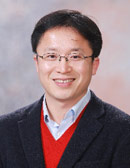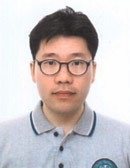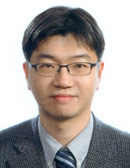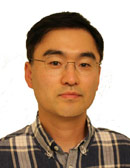时间:12月28日(周四)13:30-18:00
地点:师昌绪楼403会议室
题目1:Boosting interfacial charge transfer for efficient water splitting photoelectrodes
报告人:Professor Ho Won Jang (Seoul National University)
摘要:After a brief introduction on the principle of photoelectrochmical water splitting, we will present our recent results on water splitting photoelectrodes. Firstly, we show high performance Si-based water splitting photocathodes using transition metal chalcogenides (TMCs) such as MoS2, WS2, and MoP. It is emphasized that benign band bending and defect engineering of TMCs are crucial to enhance charge transfer processes between the light absorber and the catalytic layer and between the solid catalyst and the liquid electrolyte, respectively. Secondly, we show water oxidation performance of MnO/BiVO4/WO3/FTO photoanodes. It is revealed that charge transfer between MnO nanoparticles and the underlying BiVO4 layer is strongly depending on the ligands of MnO nanoparticles, by which the position of the band edges changes considerably. At last, we present our study on the role of plasmonic Au nanoparticles on water splitting activities of various metal oxide photonanodes. Our results indicate that shape control of Au nanoparticles is important and the catalytic hole transfer should be accompanied for direct electron injection from the nanoparticles to the metal oxide. It is shown that plasmonic resonance energy transfer can be dominant over direct energy transfer in Au NPs/BiVO4 system.
题目2:Rational Electrode Design Principles Beyond Li ion Batteries
报告人:Professor Yong-Mook Kang (Dongguk University-Seoul)
摘要:Modern technology-driven society largely relies on energy storage systems or electric vehicles for eco-friendly transportation and the use of high technology devices. Lithium rechargeable batteries are the most promising power sources because of its high energy density but still have a challenge. Graphite is the most widely used anode material in the field of lithium ion secondary battery due to its many advantages such as good cyclic performances, and high charge/discharge efficiency in the initial cycle. However, its low energy density is preventing the current lithium ion secondary battery from realizing electric vehicles or energy storage systems. So, here we will show two-fold pathways to innovatively enhance the energy density of batteries for large-scale applications. As a first way to solve this problem, we suggest high voltage application of LiCoO2, which is a conventional cathode material for Li ion battery. The surface framework of LiCoO2 is modified through a surface treatment called phosphidation, which suppressed the unwanted phase transition occurring above 4.2 V. The surface instability of LiCoO2 toward organic electrolytes is simultaneously improved by changing its surface structure from an O2-based framework to a PO4-based framework that can protect against HF attack during cycling. Phosphidated LiCoO2 is successfully synthesized that showed greater stability in its bulk and surface structures. The phosphidated form enables faster Li+ diffusion and prevents irreversible phase transitions, especially when charged above 4.2 V, and consequently demonstrates excellent cycling performance and rate capabilities. The improved kinetics and stability resulting from phosphidation make LiCoO2 highly suitable as a high-voltage cathode material for use in lithium ion batteries. Actually, lithium-air battery can be the real replacement of lithium ion secondary battery because of its high theoretical specific energy coming up to 11,140 Wh/kg. So, some of important issues related to the cathode of lithium-air battery will be also dealt with in this presentation.
题目3:Graphene doping methods and its application to the devices
报告人:Professor Soo Young Kim (Chung-Ang University)
摘要:Graphene, a single layer of sp2-bonded carbon atoms, has many unique physical properties such as excellent charge carriers, quantum hall effect, and good thermal and electrical conductivity. Because of its superior properties, graphene has been applied various electronic devices. The work-function determines the band alignment in the electronic applications for efficient hole and electron transport. Therefore, the work-function is one of important factors in the application of graphene electrode. In this work, we demonstrated that graphene films synthesized by chemical vapor deposition method can be used as thin transparent electrodes with tunable work function. AuCl3, IrCl3, MoCl3, OsCl3, PdCl2, and RhCl3 were used as p-type dopant. Li2CO3, K2CO3, Rb2CO3, and Cs2CO3 were used as n-type dopant. The roles of cation and anion in these inorganic dopants were investigated. It is found that various organic materials with fluorine bonds could tune the work-function of graphene. The thermal degradation of doped graphene is pointed out as severe problems. In order to elongate the doped state, the role of graphene films as a barrier layer for protecting against the evaporation of chlorine on metal-chloride doped graphene with thermal annealing was also investigated. Atomic force microscope, scanning electron microscope, Raman spectroscopy, and x-ray photoelectron spectroscopy were also used to identify doped graphene surface structure. It seems that the dopant ions in doping solution were formed on the surface of graphene films by spontaneous reduction of metal ions. The possible doping mechanism of graphene with metal solution and its application to the devices such as light emitting diodes, organic light emitting diodes, liquid crystal displays, and organic photovoltaic cells will be discussed. Furthermore, method of reusing Cu substrate for the synthesis of graphene will be introduced.
题目4:Photoelectrochemical water splitting from disordered metal oxide semiconductors
报告人:Professor Jong Hyeok Park (Yonsei University)
摘要:The development of new types of energy generation devices is promoted by increasing public awareness that the Earth's oil reserves could run out during this century. As the energy needs of the planet are likely to double within the next 50 years, the stage is set for a major energy shortage, unless renewable energy can cover the substantial deficit left by fossil fuels. Photoelectrochemical (PEC) solar water splitting has become a central research theme for more than four decades, still, their efficiencies remain low. Despite extensive efforts devoted to modifying photoelectrodes through various bandgap and catalysis engineering, the efficient methodologies for charge transfer at electrode/electrolyte interface remain underdeveloped. In this seminar, I will introduce various unique methods to increase light harvesting efficiency to generate hydrogen from solar light by applying disordered engineering to metal oxide materials. Especially, high efficiency TiO2, WO3, and BiVO4 photoanodes with the modification and charge transfer across the electrode/electrolyte interface will be presented.
报告人简介:
 Ho Won Jang is an Associate Professor of the Department of Materials Science and Engineering in Seoul National University. He earned his Ph.D. from the Department of Materials Science and Engineering in Pohang University of Science and Technology (POSTECH) in 2004. He worked as a Research Associate at University of Madison-Wisconsin from 2006 to 2009. Before he joined Seoul National University in 2012, he worked at Korea Institute of Science and Technology (KIST) as a Senior Research Scientist. He received Graduate Student Award in 2003 MRS Fall Meeting, Outstanding Poster Award in 2010 MRS Spring Meeting, Young Ceramist Award from Korean Ceramic Society in 2014, and Shinyang Academic Award from the College of Engineering of Seoul National University in 2016. His research interests include material synthesis and device fabrication for nanoelectronics including memristors and artificial synapses, solar water splitting cells, chemical sensors, plasmonics, and metal-insulator transition. He has published about 175 papers in international refereed journals.
Ho Won Jang is an Associate Professor of the Department of Materials Science and Engineering in Seoul National University. He earned his Ph.D. from the Department of Materials Science and Engineering in Pohang University of Science and Technology (POSTECH) in 2004. He worked as a Research Associate at University of Madison-Wisconsin from 2006 to 2009. Before he joined Seoul National University in 2012, he worked at Korea Institute of Science and Technology (KIST) as a Senior Research Scientist. He received Graduate Student Award in 2003 MRS Fall Meeting, Outstanding Poster Award in 2010 MRS Spring Meeting, Young Ceramist Award from Korean Ceramic Society in 2014, and Shinyang Academic Award from the College of Engineering of Seoul National University in 2016. His research interests include material synthesis and device fabrication for nanoelectronics including memristors and artificial synapses, solar water splitting cells, chemical sensors, plasmonics, and metal-insulator transition. He has published about 175 papers in international refereed journals.
 Prof. Yong-Mook Kang completed his B.S. (1999), M.S. (2001), and Ph.D. (2004) in Korea Advanced Institute of Science and Technology. He has been a senior researcher in Samsung SDI Co., LTD. He is currently a full professor at Department of Energy and Materials Engineering in Dongguk University-Seoul. His research area covers electrode or catalyst materials for Li rechargeable batteries and various post Li batteries, such as Li-air battery, Na rechargeable battery and so on. To date, he has co-authored more than 100 refereed journal articles, more than 50 domestic or international patents, several articles in books or proceedings, and a textbook of nano-science and electrochemical devices. For his research achievements in energy conversion & storage materials, he was elected as a TWAS (Academy of Science for Developing Worlds) Young Affiliate for the first time in South Korea, and awarded the International Collaboration Award of Australian Research Council-2010. From 2015, he has been elected as a RSC (Royal Society of Chemistry) fellow & representative of Korea.
Prof. Yong-Mook Kang completed his B.S. (1999), M.S. (2001), and Ph.D. (2004) in Korea Advanced Institute of Science and Technology. He has been a senior researcher in Samsung SDI Co., LTD. He is currently a full professor at Department of Energy and Materials Engineering in Dongguk University-Seoul. His research area covers electrode or catalyst materials for Li rechargeable batteries and various post Li batteries, such as Li-air battery, Na rechargeable battery and so on. To date, he has co-authored more than 100 refereed journal articles, more than 50 domestic or international patents, several articles in books or proceedings, and a textbook of nano-science and electrochemical devices. For his research achievements in energy conversion & storage materials, he was elected as a TWAS (Academy of Science for Developing Worlds) Young Affiliate for the first time in South Korea, and awarded the International Collaboration Award of Australian Research Council-2010. From 2015, he has been elected as a RSC (Royal Society of Chemistry) fellow & representative of Korea.
 Soo Young Kim received the B.S., M.S., and Ph. D. degrees in materials science and engineering from Pohang University of Science and Technology (POSTECH), Pohang, South Korea, in 2001, 2003, and 2007, respectively. His Ph. D. research interests include improvement of electrical and optical properties in organic light emitting diodes (OLEDs) using rare-earth metal oxide and characterization of interface dipole between metal and organic material. During his post-doctoral period in Georgia Institute of Technology, USA, he focused on converting graphene oxide to graphene using thermo-chemical nanolithography technique. After starting assistant professor in Chung-Ang University, Seoul, South Korea, in 2009, he has been interested in the modulation of the properties of two-dimensional materials such as graphene, graphene oxide, transition metal dichalcogenides, and their applications. He combined his experience about optoelectronic devices with two-dimensional materials so that his research is focused on the optimization of two-dimensional materials’ properties and their application to energy devices, such as OLEDs, organic photovoltaics, perovskite solar cells, light emitting diodes, and gas sensors. During the sabbatical year as a visiting professor at University of Chicago in 2015, he has learned the synthesis of nano particles based on metal sulfides, organic perovskite materials, and inorganic perovskite materials. Therefore, he is now trying to apply perovskite nano particles to the light emitting diodes and solar cells.
Soo Young Kim received the B.S., M.S., and Ph. D. degrees in materials science and engineering from Pohang University of Science and Technology (POSTECH), Pohang, South Korea, in 2001, 2003, and 2007, respectively. His Ph. D. research interests include improvement of electrical and optical properties in organic light emitting diodes (OLEDs) using rare-earth metal oxide and characterization of interface dipole between metal and organic material. During his post-doctoral period in Georgia Institute of Technology, USA, he focused on converting graphene oxide to graphene using thermo-chemical nanolithography technique. After starting assistant professor in Chung-Ang University, Seoul, South Korea, in 2009, he has been interested in the modulation of the properties of two-dimensional materials such as graphene, graphene oxide, transition metal dichalcogenides, and their applications. He combined his experience about optoelectronic devices with two-dimensional materials so that his research is focused on the optimization of two-dimensional materials’ properties and their application to energy devices, such as OLEDs, organic photovoltaics, perovskite solar cells, light emitting diodes, and gas sensors. During the sabbatical year as a visiting professor at University of Chicago in 2015, he has learned the synthesis of nano particles based on metal sulfides, organic perovskite materials, and inorganic perovskite materials. Therefore, he is now trying to apply perovskite nano particles to the light emitting diodes and solar cells.
 Prof. Jong Hyeok Park is an associate professor at the Department of Chemical and Biomolecular Engineering at Yonsei University, Republic of Korea. He received his PhD in chemical engineering from KAIST, Korea, in August 2004. Then, he joined University of Texas at Austin, USA, as a postdoctoral researcher in 2004 (under Prof. Allen J. Bard). Since 2008, he had been an associate professor in Sungkyunkwan University (SKKU), Korea, until 2014. He is an author and a co-author of 210 papers and 50 patents.
Prof. Jong Hyeok Park is an associate professor at the Department of Chemical and Biomolecular Engineering at Yonsei University, Republic of Korea. He received his PhD in chemical engineering from KAIST, Korea, in August 2004. Then, he joined University of Texas at Austin, USA, as a postdoctoral researcher in 2004 (under Prof. Allen J. Bard). Since 2008, he had been an associate professor in Sungkyunkwan University (SKKU), Korea, until 2014. He is an author and a co-author of 210 papers and 50 patents.